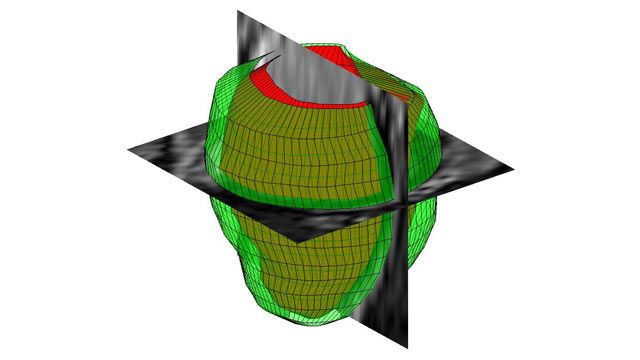Medviso Receives FDA 510(k) Approval and CE Marking for Cardiovascular Analysis Software
“Many students and researchers in our community use MATLAB, and we have released our source code to them so they can add to it. With MATLAB it is easy to debug algorithms and quickly create interfaces, making it possible to go rapidly from an idea to working software that you can demonstrate and use in the clinic.”
Challenge
Develop image analysis software for cardiac magnetic resonance imaging and secure regulatory approval for clinical use
Solution
Use MATLAB to develop, test, document, package, and deploy segmentation and quantitative analysis algorithms
Results
- Development speed tripled
- FDA submission work halved
- Algorithms delivered as production software

Three dimensional geometrical reconstruction of the human left ventricle from MR images. The green surface is the outer (epicardial) surface of the ventricle and the red surface is the inner (endocardial) surface.
Before treating a patient with an enlarged heart, congenital heart disease, or another cardiac condition, the doctor has to know how well the patient’s heart is working. Cardiac magnetic resonance (CMR) and computed tomography (CT) systems provide cross-sectional images of the heart’s structure, but these static images have limited diagnostic value. To fully understand the heart’s performance, doctors need to quantify several key measures, including how much blood the heart pumps each time it contracts, the diastolic and systolic volume of the left ventricle, the myocardial mass, and the ejection fraction, or the percentage of blood pumped on each contraction.
Researchers at Medviso have developed image analysis software that automatically quantifies these cardiac assessment measures. Developed in MATLAB®, the company’s software has received FDA 510(k) approval in the U.S. and CE marking in Europe, where it is certified to the ISO 13485 standard.
“MATLAB enabled our founder to develop the core image analysis algorithms,” says Helen Fransson, CEO of Medviso. “More recently, MATLAB made it possible for Medviso to incorporate those algorithms into standalone production software that we license to clinicians. We have streamlined regulatory approval procedures with MATLAB by automatically generating documentation and ensuring that all requirements are tested every release, as required for FDA 510(k) approval.”
Challenge
Medviso founder Einar Heiberg began developing image analysis algorithms as a researcher at Lund University in Sweden. Medviso was formed to meet a growing demand among clinicians for a packaged version of the algorithms. To deliver a production software application for clinical use, Medviso needed to extend and refine the algorithms, create a user interface, and deploy the algorithms as a standalone application.
To secure 510(k) clearance from the FDA for the software, the engineers needed to perform thorough regression tests on every release and generate extensive documentation.
Solution
Medviso used MATLAB to develop, test, document, and deploy its software.
Medviso engineers enhanced Heiberg’s original code with custom algorithms optimized to identify ventricular wall infarctions, flow measurements, and other heart features in the images. The images are read from files in the Digital Imaging and Communications in Medicine (DICOM) format.
Next, the engineers fine-tuned the algorithms that perform the remaining steps in the image analysis process using Image Processing Toolbox™. These algorithms first aggregate stacks of segmented images—each representing a 5–8 mm slice of the heart—to form a 3D representation of the heart. They measured changes in this 3D representation over a full cardiac cycle, using the results to calculate the maximum and minimum ventricular volume, ejection fraction, and other diagnostic measures.
The team created an interface for the image analysis algorithms that enables researchers and clinicians to view the images, verify or adjust the automated segmentation, read the computed diagnostic measures, and generate clinical reports.
To create a standalone version of the software that clinicians can use without installing MATLAB, the team packaged the algorithms and interface as a single application using MATLAB Compiler™.
In preparation for submitting the software for FDA approval, Medviso engineers wrote automated regression test scripts in MATLAB that verify each requirement of the software. They also wrote MATLAB scripts that generate documentation based on comments in the code.
Having received FDA 510(k) approval and a CE marking, the Segment CMR software is now used by clinicians in Europe and the U.S. and by more than 300 research groups worldwide.
Medviso recently released Segment CT, for analysis of cardiac computed tomography images. Developed in MATLAB, this application reuses about 75% of the code from Segment CMR.
Results
- Development speed tripled. “Dr. Heiberg estimates that developing and evaluating quantification algorithms in MATLAB is three to four times faster than in C/C++,” says Fransson. “The language’s array operations on matrices make it easy to process stacks of images, and MATLAB is much easier to debug because we can examine the process step-by-step to resolve problems.”
- FDA submission work halved. “We release new software every two weeks, and we need to test and document each release prior to submission to the FDA,” says Fransson. “With MATLAB we cut the work in half by automating much of this process. In 20 minutes we have all the documentation and a compiled version uploaded to our website.”
- Algorithms delivered as production software. “We created the entire user interface for our software in MATLAB,” Fransson notes. “MATLAB enabled us to very quickly create an initial version, which we showed to the researchers we work with. We incorporated their feedback and improved the design before creating the production standalone version with MATLAB Compiler.”